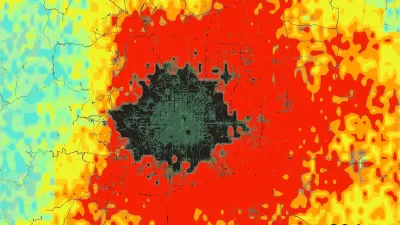Policies that encourage density as a way to reduce carbon emissions won't be able to play a significant role in reducing carbon emissions in time to counteract global warming, according to a new report from the National Academy of Sciences.
The change brought on by rapid densification, urbanization and abandonment of sprawl development patterns by 2050 would not be enough to counteract climate change brought on by carbon dioxide emissions, according to the report.
"Urban planners hoping to help mitigate CO2 emissions by increasing housing density would do better to focus on fuel-efficiency improvements to vehicles, investments in renewable energy, and cap and trade legislation now being voted on in Congress, according to the study, released Tuesday. It concludes that increasing population density in metropolitan areas would yield insignificant CO2 reductions.
Even if 75 percent of all new and replacement housing in America were built at twice the density of current new developments, and those living in the newly constructed housing drove 25 percent less as a result, CO2 emissions from personal travel would decline nationwide by only 8 to 11 percent by 2050, according to the study. If just 25 percent of housing units were developed at such densities and residents drove only 12 percent less as a result, CO2 emissions would be reduced by less than 2 percent by 2050."
FULL STORY: Forget Curbing Suburban Sprawl

Maui's Vacation Rental Debate Turns Ugly
Verbal attacks, misinformation campaigns and fistfights plague a high-stakes debate to convert thousands of vacation rentals into long-term housing.

Planetizen Federal Action Tracker
A weekly monitor of how Trump’s orders and actions are impacting planners and planning in America.

San Francisco Suspends Traffic Calming Amidst Record Deaths
Citing “a challenging fiscal landscape,” the city will cease the program on the heels of 42 traffic deaths, including 24 pedestrians.

Defunct Pittsburgh Power Plant to Become Residential Tower
A decommissioned steam heat plant will be redeveloped into almost 100 affordable housing units.

Trump Prompts Restructuring of Transportation Research Board in “Unprecedented Overreach”
The TRB has eliminated more than half of its committees including those focused on climate, equity, and cities.

Amtrak Rolls Out New Orleans to Alabama “Mardi Gras” Train
The new service will operate morning and evening departures between Mobile and New Orleans.
Urban Design for Planners 1: Software Tools
This six-course series explores essential urban design concepts using open source software and equips planners with the tools they need to participate fully in the urban design process.
Planning for Universal Design
Learn the tools for implementing Universal Design in planning regulations.
Heyer Gruel & Associates PA
JM Goldson LLC
Custer County Colorado
City of Camden Redevelopment Agency
City of Astoria
Transportation Research & Education Center (TREC) at Portland State University
Jefferson Parish Government
Camden Redevelopment Agency
City of Claremont





























